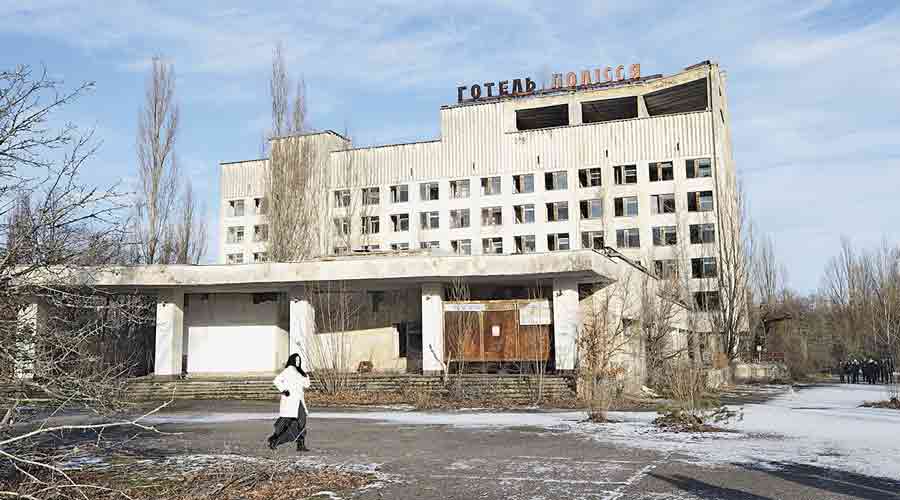Ukrainian soldiers, Kalashnikov rifles slung over their shoulders, patrolled through a silent, snowy forest, passing homes so long abandoned that vines twirl through the broken windows.
The fields are fallow, the cities deserted and the entire Chernobyl zone in northern Ukraine is still so radioactive it would seem the last place on Earth anybody would want to conquer.
But while most of the attention around a potential invasion by Russia is focused on troop build-ups and daily hostilities in the east, the shortest route from Russia to Ukraine’s capital, Kiev, is from the north. And it passes through the isolated zone around the Chernobyl power plant, where the meltdown of a reactor in 1986 caused the worst nuclear disaster in history.
In one of the incongruities of war, that makes Chernobyl an area that Ukraine thinks it needs to defend, forcing its military to deploy security forces into the eerie and still radioactive forest, where they carry both weapons and equipment to detect radiation exposure.
“It doesn’t matter if it is contaminated or nobody lives here,” said Lt Col Yuri Shakhraichuk of the Ukrainian border guard service. “It is our territory, our country, and we must defend it.”
The Ukrainian forces in the area, known as the Chernobyl Exclusion Zone, would not be sufficient to rebuff an invasion, if one came; they are there mostly to detect warning signs. “We collect information about the situation along the border” and convey it to Ukraine’s intelligence agencies, Colonel Shakhraichuk said.
The concept of the Chernobyl Exclusion Zone when Soviet authorities established it three decades ago was to limit, through isolation, the lethality of the accident at the nuclear plant. Radioactive particles left in the soil or trapped under the containment structure of the destroyed reactor while they slowly decay would pose little risk to soldiers, as long as those soldiers did not linger in highly irradiated areas. But the land must be abandoned, in some places for hundreds of years.
Two months ago, the government deployed additional forces in the area, because of increased tensions with Russia and Belarus, a Kremlin ally whose border is 8km from the stricken reactor and where Russia has recently moved troops.
“How can this be?” said Ivan Kovalchuk, a Ukrainian firefighter who helped extinguish the fire at the plant in the first days after the accident, risking his life alongside Russians and people from around the former Soviet Union. He said he was outraged that Russia could potentially menace the zone militarily.
“We liquidated the accident together,” Kovalchuk said. “For them to do this to us now just makes me feel sorry for people” in Ukraine, he said.
The Chernobyl nuclear power plant’s reactor No. 4 exploded and burned during a test on April 26, 1986, releasing about 400 times more radiation than the bombing at Hiroshima. Thirty people died in the immediate aftermath of the accident, most from radiation exposure; studies of longer-term health effects have been mostly inconclusive but suggest that there could eventually be thousands of deaths from cancer.
While the zone is uninhabitable, it does draw tourists for short visits, generating some income, and is seen in Ukraine as a teachable moment on recent history.
The Chernobyl zone covers about 1,000 square miles straddling the shortest direct route from the Belarusian border to Kiev.
Only a dozen or so soldiers were visible in the border area on a recent visit, but officials said others were patrolling elsewhere.
The zone is a sorrowful place to work. In the days after the accident, about 91,000 people were evacuated with just hours’ notice.
Forests grew around their former homes. Peering through the windows reveals clothes, shoes, dishes and other remnants of ordinary lives lying about, covered in dust and lichen.
In the largest city, Pripyat, now a ghost town, a propaganda sign still extols the virtues of civilian nuclear energy. “Let the atom be a worker not a soldier,” it reads.
The risk of a war further spreading radiation seems minimal. But one object in the zone is particularly vulnerable: a new, $1.7-billion stainless steel arch over the destroyed reactor, paid for mostly by the US and about 30 other countries. It was completed in 2016 to prevent the spread of highly radioactive dust.
New York Times News Service











